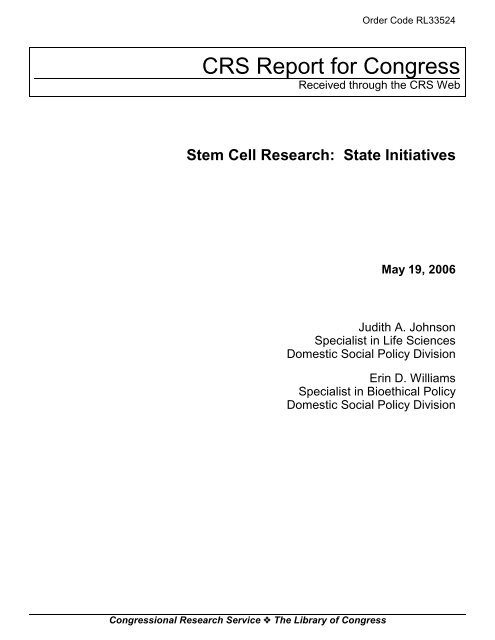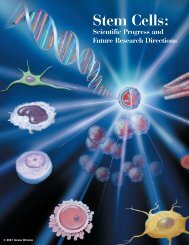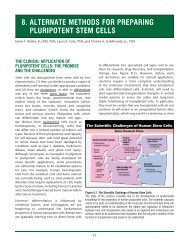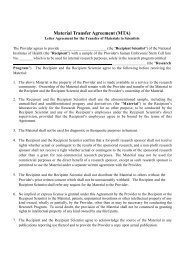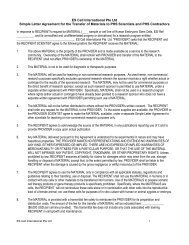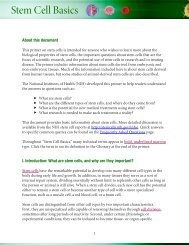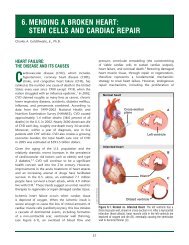Stem Cell Research: State Initiatives - Stem Cell Information
Stem Cell Research: State Initiatives - Stem Cell Information
Stem Cell Research: State Initiatives - Stem Cell Information
You also want an ePaper? Increase the reach of your titles
YUMPU automatically turns print PDFs into web optimized ePapers that Google loves.
Order Code RL33524CRS Report for CongressReceived through the CRS Web<strong>Stem</strong> <strong>Cell</strong> <strong>Research</strong>: <strong>State</strong> <strong>Initiatives</strong>May 19, 2006Judith A. JohnsonSpecialist in Life SciencesDomestic Social Policy DivisionErin D. WilliamsSpecialist in Bioethical PolicyDomestic Social Policy DivisionCongressional <strong>Research</strong> Service ˜ The Library of Congress
<strong>Stem</strong> <strong>Cell</strong> <strong>Research</strong>: <strong>State</strong> <strong>Initiatives</strong>SummaryEmbryonic stem cells have the ability to develop into virtually any cell in thebody. <strong>Stem</strong> cells are used by scientists to study the growth and differentiation ofindividual cells into tissues. This work may provide insights into the causes of birthdefects, genetic abnormalities, and other disease states, as well as potentialtreatments. The research is controversial, in the opinion of some, because the stemcells are located within the embryo and the process of removing them destroys theembryo. Some have argued that stem cell research should be limited to adult stemcells obtained from tissues such as bone marrow or umbilical cord blood becausethey believe the derivation of stem cells from embryos is ethically unacceptable.Other scientists believe that adult stem cells should not be the sole target of researchbecause of important scientific and technical limitations.Due to the controversy, federal policy has limited federal funding for researchon embryonic stem cells. In response, many states are moving forward with theirown initiatives to encourage or provide funding for stem cell research in order toremain competitive and prevent the relocation of scientists and biotechnology firmsto other states or overseas. However, without the central direction and coordinatedresearch approach that the federal government can provide, many are concerned thatthe states’ actions will result in duplication of research efforts among the states, apossible lack of oversight for ethical concerns, and ultimately a loss of U.S.preeminence in this important area of basic research. This report will be updatedperiodically.
ContentsCalifornia ................................................2Connecticut ..............................................3Florida ..................................................3Illinois ..................................................4Indiana ..................................................4Maryland ................................................4Massachusetts ............................................4Missouri .................................................5New Jersey...............................................6Ohio ....................................................6Virginia .................................................7Wisconsin................................................7Other <strong>State</strong>s ..............................................8
<strong>Stem</strong> <strong>Cell</strong> <strong>Research</strong>: <strong>State</strong> <strong>Initiatives</strong>Embryonic stem cells have the ability to develop into virtually any cell in thebody. Scientists are using stem cells to study the growth and differentiation ofindividual cells into tissues. 1 Understanding these processes could provide insightsinto the causes of birth defects, genetic abnormalities, and other disease states. <strong>Stem</strong>cells may eventually be used to produce large amounts of one cell type to test newdrugs for effectiveness and chemicals for toxicity, or they may be transplanted intoa patient to treat medical conditions such as diabetes and Parkinson’s disease.Despite its promise, only a relatively small amount of federal funding has beenused to support embryonic stem cell research. The research is controversial, in theopinion of some, because stem cells are located within the embryo and the processof removing them destroys the embryo. 2 Moreover, some of the research mayinvolve a type of cloning (see the discussion of somatic cell nuclear transfer, orSCNT, below). Many abortion opponents and others opposed to embryonic stem cellresearch believe that cloning creates a human life, even though it may consist of onlyone or a few hundred cells, and that the destruction of a cloned embryo to extractstem cells is also ethically unacceptable.Federal funding for embryonic stem cell research is limited by two factors.First, the Dickey amendment, which has been added to the Labor-Health and HumanServices-Education appropriations bill each fiscal year, starting with FY1997. Itprohibits using federal funds for the creation of human embryos for research purposesor for research in which human embryos are destroyed. Second, although the August2001 Bush Administration stem cell policy for the first time allowed federal fundsto be used for research on human embryonic stem cells, the Bush policy also limitedfederal research to only the 22 stem cell lines that were in existence in August 2001.Scientists are concerned about the quality and longevity of these 22 stem celllines. For a variety of reasons, many believe that research advancement requires thedevelopment of new embryonic stem cell lines, and for certain applications, stemcells derived from cloned embryos may offer the best hope for understanding andtreating disease. Cloned embryos are created through a process called somatic cellnuclear transfer (SCNT). 3 In SCNT, the nucleus of an egg is removed and replacedby the nucleus from a mature body cell, such as a skin cell, obtained from a patient.1For further information, see CRS Report RL33540, <strong>Stem</strong> <strong>Cell</strong> <strong>Research</strong>: Federal <strong>Research</strong>Funding and Oversight, by Judith A. Johnson and Erin D. Williams.2For further information, see CRS Report RL33554, <strong>Stem</strong> <strong>Cell</strong> <strong>Research</strong>: Ethical Issues,by Judith A. Johnson and Erin D. Williams.3For further information, see CRS Report RL31358, Human Cloning, by Judith A. Johnsonand Erin D. Williams.
CRS-2In 1996, scientists in Scotland used the SCNT procedure to produce Dolly the sheep,the first mammalian clone. When SCNT is used to create another individual, suchas Dolly, the process is called reproductive cloning. In contrast, scientists interestedin using SCNT to create cloned stem cells allow the cell created via SCNT to developfor a few days before the stem cells are removed for research. <strong>Stem</strong> cells created viaSCNT would be genetically identical to the patient, and thus would avoid any tissuerejection problems that could occur if the cells were transplanted into the patient.This is why the SCNT process is often called therapeutic cloning.Regardless of federal policy, many states are moving forward with their owninitiatives to encourage or provide funding for stem cell research (in some cases,therapeutic cloning as well) in order to remain competitive and prevent the relocationof scientists and biotechnology firms to other states or overseas. However, withoutthe central direction and coordinated research approach that the federal governmentcan provide, many are concerned that the states’ actions will result in duplication ofresearch effort among the states, a possible lack of oversight for ethical concerns, andultimately a loss of U.S. preeminence in this important area of basic research.California. In September 2002, California enacted the nation’s first law thatexpressly permits and encourages research involving the derivation of humanembryonic stem cells and cloned human embryos (California Health and Safety Code§ 123440, 24185, 12115-7, 125300-320). The law does not authorize practices thatwere previously proscribed, but instead provides assurances to researchers andsponsors hesitant to invest in embryonic stem cell research since the 2001 Bushpolicy took effect. The law has reportedly enticed several prominent researchers tomove to California from other states.In November 2004, with the endorsement of Governor Arnold Schwarzenegger,Californians passed Proposition 71 with 59% of the vote, amending the stateconstitution to facilitate embryonic stem cell research. Proposition 71 established aCalifornia Institute for Regenerative Medicine (CIRM), and authorized a bond saleto generate $3 billion for embryonic stem cell research over the next 10 years. Ninetypercent of the funds will be spent on research; 10% will go toward facilities. Allgrants will be limited to scientists and facilities in California. Funds may not be usedfor reproductive cloning but may be used for therapeutic cloning. 4 In early May2005, the 29-member governing board of CIRM, the Independent Citizens OversightCommittee (ICOC), announced that CIRM would be located in San Francisco.However, CIRM is facing legislative and legal challenges that are holding upthe bond sale. A state Senate bill sponsored by Deborah Ortiz would put an initiativeon the November ballot that requires CIRM to conduct more open meetings andrequires that a minimum royalty be returned to the state. 5 Lawsuits were filed inApril 2005 by various groups — one claims that individuals on the ICOC haveconflicts of interest that impede the ICOC’s ability to fairly allocate money; a secondcharges that CIRM violates the state constitution because it lacks proper state4Proposition 71, at [http://www.voterguide.ss.ca.gov/propositions/prop71text.pdf].5Laura Mecoy, “<strong>Stem</strong> <strong>Cell</strong> Bill Divides Ortiz, Official,” The Sacramento Bee, Apr. 20,2006, p. A3.
CRS-3oversight; and a third claims that the CIRM program violates the rights of humanembryos. 6 The first two lawsuits were consolidated, and the trial concluded in earlyMarch 2006. On April 21, 2006, the state judge ruled that the two lawsuits had nomerit. An appeal of the ruling is expected, and will probably delay resolution intonext year. 7 CIRM is funded until the end of June 2006 by a $3 million state loan anda $5 million grant from the Dolby Foundation. 8 In April 2006, the state authorizedthe sale of $14 million in bond anticipation notes to six philanthropic foundations,the first of a total of $50 million of such notes. The money will be used to fund theprogram until the lawsuits are resolved.Connecticut. In January 2005, Connecticut Governor M. Jodi Rell proposedto use $20 million of the $315 million state budget surplus for human embryonicstem cell research. 9 Both Yale University and the University of Connecticut at Storrshave labs engaged in stem cell research. In March 2005, the Storrs lab announcedthat, in collaboration with Chinese scientists, it had become the first to createembryonic stem cells from cloned cattle embryos. 10 The Storrs lab wants to begin ahuman therapeutic cloning program. Lab chief Xiangzhong “Jerry” Yang threatenedto leave for China if state funding was not provided. On June 15, 2005, GovernorRell signed legislation providing $100 million over 10 years for human embryonicstem cell research. 11 On May 9, 2006, the Connecticut <strong>Stem</strong> <strong>Cell</strong> <strong>Research</strong> AdvisoryCommittee approved guidelines for scientists who apply for research grants from the$100 million state fund; grants will be awarded as early as September 2006. 12Florida. An amendment to the Florida constitution that would provide $20million per year for 10 years for embryonic stem cell research has been submitted tothe state Division of Elections for approval as a ballot initiative. The initiative,sponsored by the Palm Beach County group Floridians for <strong>Stem</strong> <strong>Cell</strong> <strong>Research</strong> andCures, also needs the approval of the Florida Supreme Court. Supporters arecurrently collecting signatures for the initiative to appear on the 2008 ballot. 136Steve Johnson, “Lawsuits Will Delay <strong>Stem</strong>-<strong>Cell</strong> <strong>Research</strong>,” The Mercury News, Aug. 2,2005, p. 1.7Lee Romney, “Judge Upholds <strong>Stem</strong> <strong>Cell</strong> Initiative,” The Los Angeles Times, Apr. 22, 2006,p. B1.8Andrew Pollack, “$14 Million for <strong>Research</strong> on <strong>Stem</strong> <strong>Cell</strong>s,” The New York Times, Apr. 5,2006, p. 12.9Marcel Przymusinski and Susie Poppick, “Locals Seek More <strong>Stem</strong> <strong>Cell</strong> Funds,” Yale DailyNews, Jan. 26, 2005.10William Hathaway, “<strong>State</strong> Lab Nears Cloning Goal, UConn Scientist: Creating HumanEmbryonic <strong>Cell</strong>s is Within Sight,” The Hartford Courant, Mar. 25, 2005, p. A1.11Fran Silverman, “$100 million Commitment for <strong>Stem</strong> <strong>Cell</strong> <strong>Research</strong>,” The New YorkTimes, June 19, 2005, p. 2.12William Hathaway, “<strong>Stem</strong> <strong>Cell</strong> Grants Now Available,” The Hartford Courant, May 10,2006, p. B9.13Josh Hafenbrack, “<strong>Stem</strong> <strong>Cell</strong> Showdown Heats Up,” South Florida Sun-Sentinel, Dec. 6,2005, p. 1A.
CRS-4Illinois. Following the defeat of several stem cell research measures during thespring 2005 session of the Illinois legislature, on July 12, 2005, Governor RodBlagojevich signed an executive order authorizing $10 million in funding for adult,cord blood, and embryonic stem cell research. The money was added to the budgetof the Illinois Department of Public Health. 14 In August 2005, as Missouri legislatorswere debating whether to ban such research, Governor Blagojevich sent a letter toMissouri scientists and researchers inviting them to move to Illinois and find the“freedom to explore the promise of stem cell research.” 15 In April 2006, the statehealth department, after reviewing 24 applications, awarded 10 grants to sevenresearch centers in Illinois. 16 Governor Blagojevich plans to push for the passage ofa five-year $100 million state research program for embryonic stem cell research. 17Indiana. In May 2005, Indiana enacted legislation that prohibits reproductiveand therapeutic cloning and creates an adult stem cell research center at IndianaUniversity, but did not provide any state funding for the center.Maryland. On March 28, 2005, in an 81-53 vote, the Maryland Houseapproved a bill that would provide $23 million each year for human embryonic stemcell research, including therapeutic cloning, beginning in FY2007. However, the billdied in the Senate in April 2005 on the last day of the legislative session due to athreatened filibuster. 18 In January 2006, Governor Robert L. Ehrlich announced a$20 million state funding proposal for stem cell research. 19 In March 2006, theMaryland legislature passed a bill providing $15 million over one year; GovernorEhrlich signed the legislation in April 2006. 20Massachusetts. In March 2005, the Massachusetts legislatureoverwhelmingly approved a bill (Senate 35-2, House 117-37) that clarifies state lawon research involving human embryonic stem cells and therapeutic cloning, andensures that such research is permitted within a regulatory framework. On May 27,2005, Governor Mitt Romney vetoed the stem cell bill; he was opposed to the14John Chase, “Governor Slips <strong>Stem</strong>-<strong>Cell</strong> Grant by Lawmakers,” Chicago Tribune, July 13,2005, p. 1.15Paul Hampel, “Illinois Governor Invites <strong>Stem</strong> <strong>Cell</strong> <strong>Research</strong>,” St. Louis Post Dispatch,Aug. 29, 2005, p. B1.16Press Release, Office of the Governor, “Gov. Blagojevich, Comptroller Hynes Announce$10 Million in <strong>State</strong> <strong>Stem</strong> <strong>Cell</strong> <strong>Research</strong> Grants,” Apr. 24, 2006 [http://www.idph.state.il.us/public/press06/4.24.06<strong>Stem</strong><strong>Cell</strong>Grants.htm].17Kate Clements, “Governor Urges Passage of Program,” The News Gazette, Mar. 21, 2006,p. A3.18David Nitkin, Sumathi Reddy, and Ivan Penn, “<strong>Stem</strong>-<strong>Cell</strong> Bill Dies in Senate ThreatenedFilibuster on <strong>Research</strong> Funding Spelled End For Legislation,” Baltimore Sun, Apr. 12, 2005,p. A1.19John Wagner, “Ehrlich Hopes to Spend $20 Million on <strong>Stem</strong> <strong>Cell</strong> <strong>Research</strong>,” TheWashington Post, Jan. 11, 2006, p. B2.20Jennifer Skalka, “Legislators OK <strong>Stem</strong> <strong>Cell</strong> Bill,” The Baltimore Sun, Mar. 30, 2006, p.1A.
CRS-5therapeutic cloning portion of the bill. On May 31, 2005, the House overrode theGovernor’s veto on a vote of 112 to 42; the Senate did the same later that day on avote of 35-2. 21 <strong>State</strong> funding of research was not provided. In May 2006, aDemocratic candidate for Governor, Chris Gabrieli, proposed that the state provide$1 billion for embryonic stem cell research and life science research over a 10-yearperiod. 22Missouri. In May 2006, the Missouri Coalition for Lifesaving Cures submittedto the Missouri Secretary of <strong>State</strong> a petition with 288,991 signatures, more thanenough to place an initiative in support of stem cell research on the November 2006statewide ballot. 23 If voters approve, Missouri would join California as the secondstate to place protections for conducting stem cell research in the state constitution.Former U.S. Senators Thomas Eagleton and John Danforth, an ordained Episcopalpriest, are members of the coalition. 24 Supporters of the initiative include GovernorMatt Blunt, the Lance Armstrong Foundation, the Christopher Reeve Foundation, theNational Parkinson Foundation and the American Diabetes Association. Theamendment would ban human reproductive cloning but protect all stem cell researchpermitted by federal law, including therapeutic cloning. The petition is in responseto efforts in the state legislature that would criminalize such research in the state.The Stowers Institute for Medical <strong>Research</strong>, a private institution in Kansas City witha $2 billion endowment, has stopped hiring and delayed a $300 million expansionuntil the status of research is resolved either by the legislature or by the public via thepetition. Instead, Stowers made a $6 million donation to the Harvard <strong>Stem</strong> <strong>Cell</strong>Institute in 2005. 25A lawsuit filed in November 2005 asks the court to block the petition signingbecause it claims that the ballot language, which states the amendment would “banhuman cloning or attempted human cloning,” is deceptive. 26 Many abortionopponents and others opposed to embryonic stem cell research believe thattherapeutic cloning creates a human life, even though it may consist of only one ora few hundred cells, and therefore the amendment is sanctioning a type of humancloning. The suit was filed by the Arizona-based Alliance Defense Fund on behalfof Missourians Against Human Cloning. The Missouri Catholic Conference and theMissouri Baptist Convention joined the case in December 2005. On January 19,2006, after five hours of testimony, the Circuit Court Judge ruled in favor of the21Raphael Lewis, “<strong>Stem</strong> <strong>Cell</strong> Bill Override Turns to Talk of <strong>Research</strong> Support,” The BostonGlobe, June 1, 2005, p. A1.22Andrea Estes, “Gabrieli to Offer a $1B <strong>Stem</strong> <strong>Cell</strong> Plan,” The Boston Globe, May 11, 2006,p. B1.23Press Release, Missouri Coalition for Lifesaving Cures, “<strong>Stem</strong> <strong>Cell</strong> Supporters SubmitMore Than Enough Signitures to Qualify <strong>Stem</strong> <strong>Cell</strong> Initiative for Missouri Ballot,” May 1,2006 [http://www.missouricures.com/documents/rel_050106.pdf].24Matthew Franck, “Court Allows Two Church Groups to Join <strong>Stem</strong> <strong>Cell</strong> <strong>Research</strong>Lawsuit,” St. Louis Post Dispatch, Dec. 16, 2006, p. C7.25Peter Slevin, “Mo. May Vote on <strong>Stem</strong> <strong>Cell</strong> <strong>Research</strong>,” The Washington Post, Dec. 25,2005, p. A4.26“Judge to Allow <strong>Stem</strong> <strong>Cell</strong> Debate,” The Kansas City Star, Dec. 26, 2005, p. 3.
CRS-6ballot language, stating that it was “sufficient, fair, accurate and impartial.” 27 Theruling was appealed by Alliance Defense Fund, and in March 2006, the <strong>State</strong> AppealsCourt ruled to uphold the language of the ballot proposal. 28New Jersey. In January 2004, New Jersey became the second state in thenation to enact a law that specifically permits embryonic stem cell research. Thestate law bans human reproductive cloning but permits the use of cloned embryos forstem cell research (NJ Permanent Statutes, Title 26:2Z-2). Like the 2002 Californialaw, New Jersey’s stem cell statute provides assurances to researchers and does notcontradict the 2001 Bush policy, which only limits federal funding.In May 2004, Governor James McGreevey signed a bill to create the firststate-funded embryonic stem cell research center, a $25 million endeavor. 29 Thelegislature funded the measure on June 25, 2004, passing a state budget that allocates$11.5 million to the newly chartered <strong>Stem</strong> <strong>Cell</strong> Institute of New Jersey. 30In December 2005, the New Jersey Commission on Science and Technologyannounced that it would be awarding 17 grants on stem cell research totaling $5million; three of the grants focus on human embryonic stem cell research. 31Legislation that would invest up to $250 million in stem cell research is stalledin the state legislature, its fate tied to a controversial but unrelated bill on needleexchange. 32 Both proposals are backed by Governor Jon Corzine. The stem cellproposal would build a $150 million <strong>Stem</strong> <strong>Cell</strong> <strong>Research</strong> Institute in New Brunswickon the campus of Rutgers University, and provide $50 million for a biomedicalresearch facility in Camden, and $50 million for a laboratory at the New JerseyInstitute of Technology in Newark. Funding for the proposal would come from thesale of state bonds to be repaid by revenue from cigarette taxes.Ohio. The Center for <strong>Stem</strong> <strong>Cell</strong> and Regenerative Medicine was started in2003 with $19.5 million in funding from the state of Ohio. 33 The center is composedof researchers from Case Western Reserve University, University Hospitals ofCleveland, The Cleveland Clinic Foundation, Athersys, Inc., and Ohio <strong>State</strong>University. The center uses adult human stem cells and tissue engineeringtechnology to develop treatments for human disease. On June 30, 2005, Governor27Kit Wager, Judge Approves Ballot Language for <strong>Stem</strong> <strong>Cell</strong> Vote, The Kansas City Star,Jan. 20, 2006, p. 1.28Associated Press, “<strong>Stem</strong> <strong>Cell</strong> Ballot Language Upheld,” Mar. 28, 2006.29“U.S. <strong>State</strong>s Making <strong>Stem</strong> <strong>Cell</strong> Policies,” Bionews, no. 258, May 5, 2004.30Barbara Mantel, “Analysis: New Jersey Is First <strong>State</strong> to Fund <strong>Research</strong> on <strong>Stem</strong> <strong>Cell</strong>s,”NPR: All Things Considered, June 25, 2004.31Kitta MacPherson, “NJ <strong>Stem</strong> <strong>Cell</strong> <strong>Research</strong> Takes a First Step as <strong>State</strong> Awards $5M,” TheStar-Ledger, Dec. 17, 2005, p. 1.32Jeff Whelan and Josh Margolin, “Stalling on Two Sensitive Bills Angers Corzine,” TheStar-Ledger, Apr. 18, 2006, p. 1.33[http://ora.ra.cwru.edu/stemcellcenter/].
CRS-7Bob Taft vetoed language in the state budget that would have prevented stateresearch funds from being used for human embryonic stem cell research. The vetoallows state funds to be used for research on human embryonic stem cell lines thatexisted before August 2001, in accordance with Bush Administration policy. 34 InMay 2006, the Third Frontier Commission approved an $8 million grant in statefunds to Case Western Reserve University for the Center for <strong>Stem</strong> <strong>Cell</strong> andRegenerative Medicine. 35 The Third Frontier Project was started by Governor Taftin February 2002 in an effort to expand the state’s high-tech research capabilities,promote innovation, company formation, and high-paying jobs.Virginia. In March 2005, Virginia enacted legislation that would fund researchon adult stem cells via state appropriations to the Christopher Reeve <strong>Stem</strong> <strong>Cell</strong><strong>Research</strong> Fund. A joint subcommittee was also established to examine the medical,ethical, and scientific policy implications of stem cell research.Wisconsin. In response to the California initiative, Wisconsin Governor JimDoyle announced on November 17, 2004, that the state was providing nearly $750million in public-private investment for biotechnology, health sciences, and stem cellresearch over the next several years. 36 The Wisconsin investment strategy includes$375 million for a new research institute, the Wisconsin Institute for Discovery, onthe University of Wisconsin-Madison campus. Wi<strong>Cell</strong>, a foundation that is usingprivate and federal funds to support stem cell research, will be a part of the institute.The state also plans to invest $105 million over the next five years in research,education, and public health efforts at the University of Wisconsin Medical Schooland the Medical College of Wisconsin for stem cell research, as well as regenerativemedicine, molecular medicine, neuroscience, and cancer research.In June 2005, the Wisconsin <strong>State</strong> Assembly passed a bill (59 to 38) prohibitingboth reproductive and therapeutic cloning; the Senate passed the bill (21 to 12) inSeptember 2005. Governor Doyle vetoed the bill on November 3, 2005, stating thatthe “bill would criminalize some of the most promising scientific techniques used bystem cell researchers, not only potentially delaying cures to some of humanity’soldest and deadliest diseases but also costing Wisconsin jobs in the future.” 37In April 2006, the University of Wisconsin announced plans for building thenew Wisconsin Institute for Discovery with an additional $100 million in privatefunding and $50 million in previously approved state funding. The first phase ofconstruction will begin in late 2007. 3834“Ohio Governor Vetoes <strong>Stem</strong> <strong>Cell</strong> Budget Limitations,” <strong>Research</strong> Policy Alert, July 6,2005.35Mary Vanac, “NE Ohio Grabs Lots of Biotech Grant Money,” The Plain Dealer, May 13,2006, p. C1.36[http://www.wisgov.state.wi.us/journal_media_detail_print.asp?prid=832].37[http://www.wisgov.state.wi.us/docview.asp?docid=5302].38Megan Twohey, et al., “<strong>Research</strong> Hub at UW Gets Huge Gift,” The Milwaukee JournalSentinel, Apr. 4, 2006, p. A1.
CRS-8Other <strong>State</strong>s. Other states, including Delaware, Pennsylvania, Texas, andNew York are considering legislative options to remain competitive in embryonicstem cell research and prevent the possible relocation of their scientists andbiotechnology firms. 3939Kelly Rayburn, “<strong>State</strong>s Grapple with <strong>Stem</strong> <strong>Cell</strong> <strong>Research</strong>,” The Wall Street Journal, Dec.24, 2004, p. A4; Martin Kasindorf, “Calif. Moves Fast on <strong>Stem</strong> <strong>Cell</strong> Grants,” USA Today,Dec. 17, 2004, p. A3; Andrew J. Hawkins, “<strong>State</strong> <strong>Stem</strong> <strong>Cell</strong> Efforts Gain Momentum inWake of California’s Prop 71,” Washington Fax, Jan. 18, 2005.


